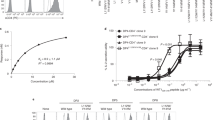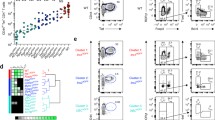Abstract
Among the HLA-DR-specific monoclonal antibodies (mAbs) that have been characterized previously, there is a marked shortage of DRα chain-specific mAbs which stain unfixed cells. This may result from the high degree of sequence similarity between the α1 domains of HLA-DR and H-2E leading to a state of cross-tolerance to DRα in H-2-expressing mice. BALB/b (E-negative) mice were immunized with DR1-transfected mouse L cells. The chain specificity of the resulting DR-specific mAb was determined using a panel of transfectants expressing hybrid mouse/human class II heterodimers. A DRα-specific mAb was generated which was capable of immunoprecipitating DRαβ dimers and inhibiting the anti-DR alloresponse of human T-cell clones. The present study demonstrates that, with the selection of suitable recipient strain, transfectants can be useful in the generation and definition of chain-specific mouse mAbs.
Similar content being viewed by others
References
Barnstaple, C. J., Bodmer, W. F., Brown, G., Galfre, G., Milstein, C., Williams, A. F., and Ziegler, A.: Production of monoclonal antibodies to group A erytrocytes, HLA and other human cell surface antigens. Cell 14: 9–15, 1978
Benoist, C. O., Mathis, D. J., Kanter, M. R., Williams, V. E., and McDevitt, H.O.: The murine Ia α chains, Eα and Aα, show a surprising degree of sequence homology. Proc Natl Acad Sci USA 80: 534–538, 1983
Bhattavharya, A., Dorf, M. E., and Springer, T. A.: A shared alloantigenic determinant on Ia antigen encoded by the I-A and I-E subregions: evidence for I region gene duplication. J Immunol 127: 2488–2495, 1981
Bjorkman, P. J., Saper, M. A., Samraoui, B., Bennett, W. S., Strominger, J. L., and Wiley, D. C.: Structure of the human class I histocompatibility antigen HLA-A2. Nature 329: 506–511, 1987
Bodmer, J. G., Kennedy, L. J., Aizawa, M., Dawkins, R. L., Lepage, V., Mazzilli, M. C., and Richiardi, P.: HLA-D region monoclonal antibodies. In E. D. Albert, M. P. Baur, and W. R. Mayr (eds.): Histocompatibility Testing 1984, pp. 217–236, Springer, Berlin, 1984
Braunstein, N. S. and Germain, R. N.: Allele-specific control of Ia molecule surface expression and conformation: implications for a model Ia structure-function relationship. Proc NAtl Acad Sci USA 84: 2921–2925, 1987
Brodsky, F. M., Parham, P., and Bodmer, W. F.: Monoclonal antibodies to HLA-DRw determinants. Tissue Antigens 16: 30–48, 1980
Brown, J. H., Jardetxky, T., Saper, M. A., Samraoui, B., Bjorkman, P. J., and Wiley, D. C.: A hypothetical model of the foreign antigen binding site of class II histocompatibility molecules. Nature 332: 845–850, 1988
DeKrestser, T. A., Crumpton, M. J. Bodmer, G., and Bodmer, W. F.: Demonstration of two distinct light chains in HLA-DR-associated antigens by two-dimensional gel electrophoreis. Eur J Immunol 12: 214–221 1982
Goyert, S. and Silver, J.: Further characterization of HLA-DS molecules: implications for studies assesing the role of human Ia molecules in cells interactions and disease susceptibility. Proc Natl Acad Sci USA 80: 5719–5723, 1983
Guy, K., Van Heyningen, V., Cohen, B. B., Deanne, D. L., and Steel, C. M.: Differential expression and serological distinct sub-populations of human Ia antigens detected with monoclonal antibodies to Ia alpha-chain and beta-chain. Eur J Immunol 12: 942–948, 1982
Hudson, L. and Hay, F. C.: Immunoprecipitation and SDS polyacrylamide gel electrophoresis. In Hudon, L. and Hay, F. C. (ed.): Practical Immunology, 3rd edn, pp 65–73, Blackwell, Oxford, 1989
Klein, E., Klein, G., Nadkarni, J. S., Wigsell, H., and Clifford, P.: Surface IgM-kappa specificity on a Burkitt lymphoma cell in vivo and in derived culture lines. Cancer Res 28: 1300–1310, 1968
Lampson, L. A. and Levy, R.: Two populations of I-a like molecules on a human B cell line. J Immunol 125: 293–299, 1980
Landais, D., Beck, B. N., Buerstedde, J. M., Degraw, S., Klein, D., Koch, N., Murphy, D., Pierres, M., Tada, T., Yamamoto, K., Benoist, C., and Mathis, D.: The assignment of chain specificities for anti-Ia monoclonal antobodies using L cell transfectants. J Immunol 137: 3002–3005, 1986
Lecher, R. I., Bal, V., Roothbard, J. B., Sekaly, R., Long, E. O., and Lamb, J.: Structural and functional studies of HLA-DR restricted antigen recognition by human helper T lymphocyte clones by using transfected murine cell lines. J Immunol 141: 3003–3009, 1988
Lechler, R. I. Sant, A. J., Braunstein, N. S., Sekely, R., Long, E. and Germain, R. N.: Cell surface expression of hybrid murine/human MHC class IIβα dimers: key inlfuence of residues in the amino-terminal portion of the β1 domain. J Immunol 144: 329–333, 1990
Lee, J. S., Trowsdale, J., Travers, P. J., Carey, J., Grosveld, F., Jenkins, J., and Bodmer, W. F.: Sequence of an HLD-DR α-chain cDNA clone and intron-exon organization of the corresponding gene. Nature 229: 750–752, 1982
Lombardi, G., Sidhu, S., Lamb, J., Batchelor, R., and Lecher, R.: Co-recognition of endogenous antigens with HLA-DR1 by alloreactive human T cell clones. J Immunol 142: 753–759, 1989a
Lombardi, G., Sidhu, S., Batchelor, J. R., and Lecher, R. I.: Allorecognition of DR1 by T cells from a DR4/DRw13 responder mimics self-restricted recognition of endogenous peptides. Proc Natl Sci USA 86: 4190–4194, 1989b
Mathis, D. J., Benoist, C., Williams, V. E., Kanter, M., and McDevitt, H. O.: Several mechanisms can account for detective Eα gene expression in different mouse haplotypes Proc Natl Acad Sci USA 80: 273–277, 1983
Mentzer, S. J., Barbosa, J. A., Strominger, J. L., Biro, P. A., and Burakoff, S. J.: Restricted recognition of transfected HLA-A2 and HLA-B7 by human CTL clones. J Immunol 137: 408–413, 1986
Oi, V. T., Jones, P. P., Gotting, J. W., Herzenberg, L. A., and Herzenberg, L. A.: Properties of monoclonal antibodies to mouse Ig allotype, H-2, and Ia antigens. Curr Top Microbiol Immunol 7: 115–121, 1978
Ozato, K., Mayer, N. M., and Sachs, D. H.: Hybridoman cell lines secreting monoclonal antibodies to mouse H-2 and Ia antigen. J Immunol 124: 533–540, 1980
Pierres, M., Devaux, C., Dosseto, M., and Marchetto, S.: Clonal analysis of B- and T-cell responses to Ia antigens. I. Topology of epitope regions on I-Ak and I-Ek molecules analyzed with 35 monoclonal antibodies. Immunogenetics 14: 481–495, 1981
Author information
Authors and Affiliations
Rights and permissions
About this article
Cite this article
Palmer, D., Kevany, M., Mackworth-Young, C. et al. Generation and characterization of an HLA-DRα-specific monoclonal antibody using L-cell transfectants expressing human and mouse class II major histocompatibility dimers. Immunogenetics 33, 12–17 (1991). https://doi.org/10.1007/BF00211690
Received:
Revised:
Issue Date:
DOI: https://doi.org/10.1007/BF00211690




